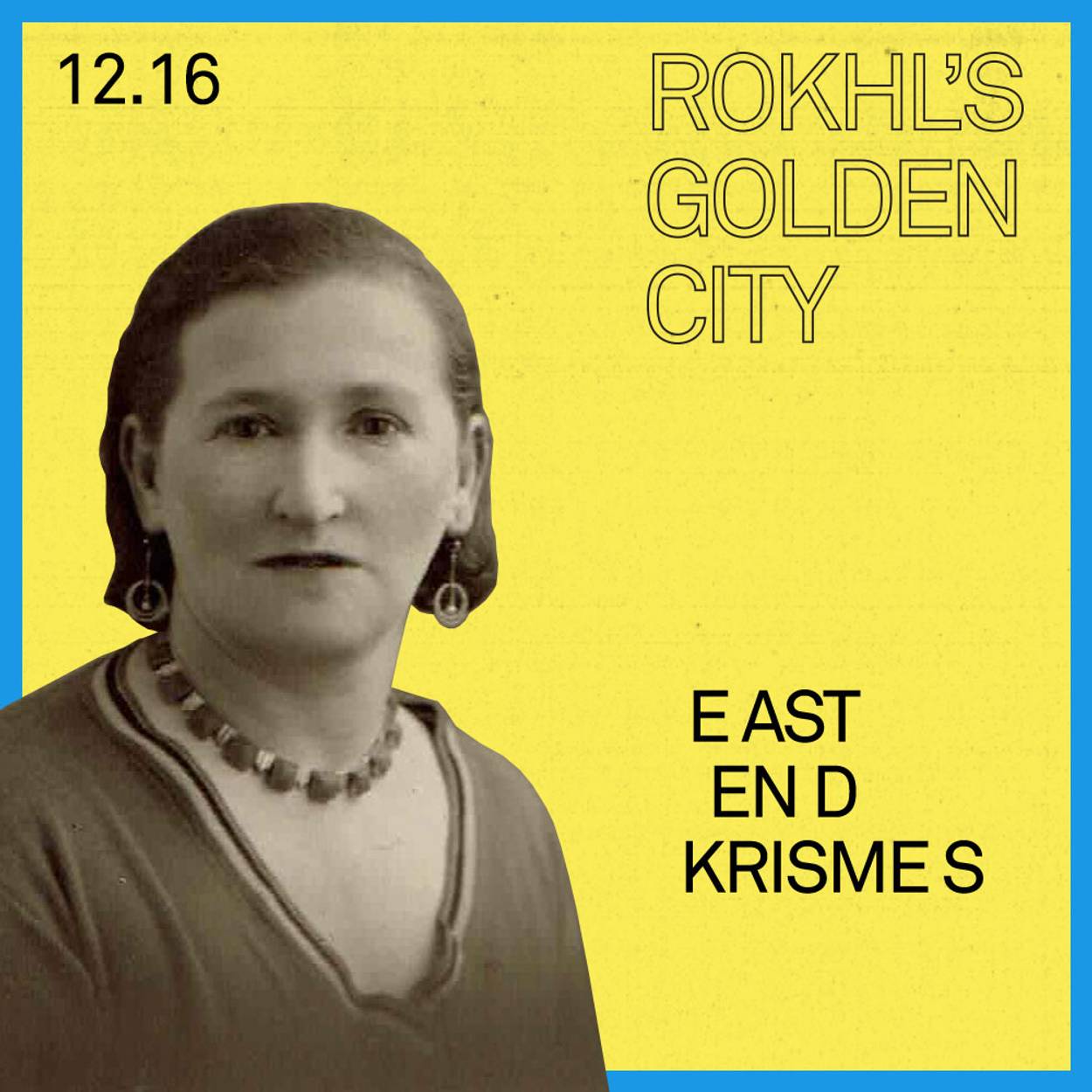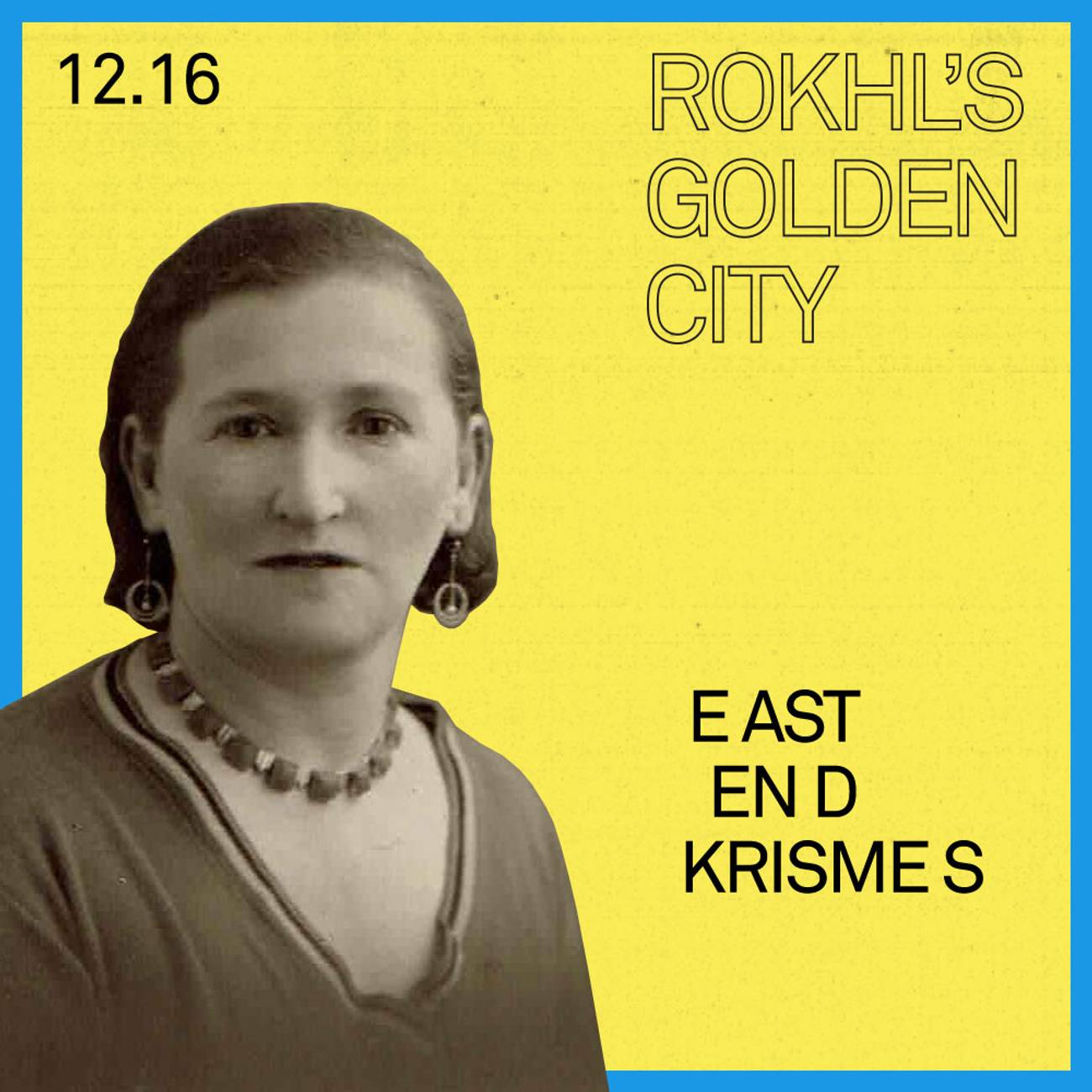British Yiddish
Rokhl’s Golden City: London’s Yiddish literary delights




“I don’t know what it’s like in other Jewish homes, but in ours, I find it so stressful every year when the holy festival of krismes comes round. My children simply drive me crazy, constantly making plans for how to celebrate it.”
If you think the “December dilemma” is either new or American, Katie Brown’s gently biting short story “Krismes Prezents” will add an essential new layer to that history. Brown published “Krismes Prezents” in the London Yiddish press in the 1930s.
The narrator of the story tells us that her children are insisting she buy them Christmas presents—and more than presents, she is told she must host a Christmas party in their home, with a tree, nokh (yet)!
“While I don’t like the idea of celebrating krismes—it was never done in my parents’ home or anywhere in my family—I never say anything as long as they celebrate it at their friends’ houses.”
The sharpness of “Krismes Prezents” sneaks up on you, hidden at first by its gentle comic tone. We’re lucky to now have London Yiddishtown: East End Jewish Life in Yiddish Sketch and Story, 1930-1950, a brand-new volume featuring a number of Brown’s stories, never before translated into English. Translator, scholar, and vocalist Vivi Lachs has done heroic work in excavating the forgotten works of three chroniclers of East End Yiddish life: Brown, A.M. Kaiser, and I.A. Lisky.
The work of these three authors appeared in the London Yiddish press at a time when Yiddish in the U.K. was already on a fairly sharp downturn. Nonetheless, all three were members of a vibrant Yiddish-language cultural scene. Brown, for example, also wrote songs and plays for the Yiddish theater, and was produced by both amateur and professional groups. Her home off Brick Lane was “a magnet for writers, actors, and her many friends, who came to sing theatre songs and talk about the Yiddish theatre.”
Brown (born with the shtetl-fabulous name of Gitl Bakon) was a local celebrity, recognized on the street. A female celebrity is still a female celebrity, however. The reviews for her first short story collection all made mention of her “female sensibility,” though such condescension didn’t seem to harm sales, with her book outselling Yiddish language books by all her contemporaries.
Lisky was a communist and a member of the heavily communist Jewish Cultural Club, Jewish Fund for Soviet Russia, and the London YKUF (yidisher kultur-farband). Lisky’s politics shaped his fiction, as well as his life, and his apparently stormy marriage to fellow activist “Seedo” (Sonia Husid). I’d pay to see a six-part prestige drama just about their time as a premier power couple in the transnational world of London Yiddish letters.
Lisky’s short story “Productivization” is included in London Yiddishtown and it’s a testament to translator Vivi Lachs that Lisky’s prose comes across as vividly as it does. Our protagonist Sam Stricker has gone to see his landlord, “a squat man, built like a safe: tough, rich, and always locked into his own thoughts.” Oof!
Lisky’s London stories were criticized at the time for being too ideologically driven. And Lisky’s politics aren’t exactly hidden. But the drama at the heart of “Productivization” is deeply personal and human. An immigrant worries about his London-born son, a clever boy who has won a scholarship to study medicine and a ticket out of the ghetto. But this is the period of great activity by the British Union of Fascists and their leader, Oswald Mosley. The established, assimilated leadership of British Jews was counseling Jews to keep their heads down, and to avoid adding to Jewish overrepresentation in the professional classes, like Sam’s fictional son. Sam’s pals at the local restaurant are far more interested in a muscular response, meeting provocation with fists and a veritable rain of pamphlets.
What is the proper response to ascendant fascism? What is to be the response of Jews as a group? As individuals? Lisky raises these questions skillfully, and Lachs provides ample historical and literary context for each author and story. Lachs is a dear friend of mine, but I’d say this even if I didn’t already admire her: Her work in London Yiddishtown is simply superb, and a fitting follow up to her hilarious and brilliant first book, Whitechapel Noise: Jewish Immigrant Life in Yiddish Song and Verse, 1884-1914.
All three authors, Lisky, Kaiser, and Brown, were part of the literary salon run for decades by the Yiddish author A.N. Stencl. Stencl shows up all over the histories of Yiddish London. He was long-lived, prolific, and a hub for an entire cultural scene. Like many Eastern European-born Yiddish writers, he immigrated to Berlin in 1921. A biographical sketch of Stencl on the SOAS Library website says of that time: “He was to flourish in the bohemian lifestyle that Germany offered, frequenting the Romanisches Café and meeting like-minded writers and intellectuals.” But after arrest and torture by the Gestapo in 1936, Stencl sensibly made his departure from Germany, ending up in London, where he edited a literary journal called Loshn un lebn from 1946-81, along the way acquiring the title of the Poet of Whitechapel.
Stencl’s papers were donated to the SOAS University of London library in 1983. But it is only now that his archive has been made truly accessible. A large portion of the journal Loshn un lebn is now available digitally; a new, bilingual finding aid has been created; and a great deal of previously uncataloged material has been cataloged. Stencl’s archive is truly a treasure trove for what it offers in terms of researching his own work, but even more, it will give researchers a new perspective on so many of the authors and cultural workers in his orbit.
To mark the occasion, SOAS contacted friend of the column, singer/composer Polina Shepherd, asking her to set some of Stencl’s poetry to music. Just by chance, Shepherd already had a poem of Stencl’s on her proverbial desk. Nonetheless, upon receiving the commission, Shepherd was in contact with the London Yiddish community, which responded with enormous generosity. She composed music for two of Stencl’s poems and her setting of "Halbe levone" Half Moon) is simply stunning.
Who hung it in front of my window,
The young moon after such a rainy night?
With a half her face she looked at me,
and with the other half she laughed at me
Or you can watch the whole Singing Stecl program.
If you walk down Brick Lane today, there are precious few tangible links to its once thriving Yiddish community. That doesn’t mean Yiddish doesn’t have a lively existence in its 21st-century form. Right now, University College London boasts a serious lineup of scholars working on and teaching Yiddish (including newly transplanted friend of the column, Sonia Gollance). At the outset of the pandemic in 2020, this talented team applied their unique sociolinguistic skills to assisting in health and science communication in Yiddish-speaking communities like Stamford Hill.
The Yiddish-speaking Hasidic world of contemporary Stamford Hill feels like a million literary miles from the cultural bustle of interwar Whitechapel. Even so, London is not such a big city. Lachs writes that one of her authors, A.M. Kaizer, had a younger brother, Shlomo, who lived in Hasidic Stamford Hill. Like many who lived through those decades of global shifts, Kaiser’s extended family was, as Lachs writes, “fractured.” Even so, it’s interesting to think not in terms of closed-off worlds of literary and Hasidic Yiddish, but of trans-neighborhood networks, whose connections are constantly being knocked down, only to be remade once again, in ever surprising ways.
MORE: If you’re looking to play music, the Klezjammers Facebook page is a good place to start. … Yiddish House is a “London-based grassroots group spreading Yiddish language and culture by organising meetings and events and collaborating with other like-minded initiatives, organisations or institutions in the U.K. and worldwide.” The London Yiddish Open Mic is open to Yiddish speakers all over the world. … Looking ahead, June 2022 will be an in-person Yiddish Sof-Vokh (weekend), the “first U.K. weekend of Yiddish.” … Vivi Lachs will speak about her new book, London Yiddishtown, at a Yiddish Book Center Great Jewish Books Online event, Dec. 12 at 1 p.m. … Lachs will be at Yiddish New York with three different lectures on the writers featured in the book. Dec. 27, 28, and 29. For those wanting to buy her book online, right now there is a 45% discount from Wayne State University Press.
ALSO: Golden City favorites Litvakus klezmer collective will play a live concert with Forshpil Duo. Dec. 27 at Rockwood Music Hall, on New York’s Lower East Side. Tickets here … My teacher Hankus Netsky is offering an online klezmer intensive through the Osher Lifelong Learning Institute at Brandeis. “Klezmer: From Roots to Revival” is a five-session lecture series, starting Jan. 10. More information here … On Jan. 11, Daniela Smolov Levy will give the first in her five-part (!) series, “Italian Opera for the Yiddish-Speaking Masses in Early 20th-Century America.” Tickets here … I just received this call for submissions for a new zine called Heymish. It’s a project of Sarah Biskowitz and Cameron Bernstein and their Instagram account, @yiddishistke. They’re looking for short writing (as short as one paragraph) in Yiddish (or art with Yiddish captions) about what home or hominess means to you, in any sense (hometown, chosen family, etc.) Submit here.
Rokhl Kafrissen is a New York-based cultural critic and playwright.